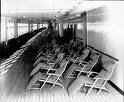Second Order Change

I take a break from the Covenant series today to reflect on change. I know, I know, change has been so done, we're sick to death of it. The endless strategies for inducing it, for enforcing it, for managing it. But today, I want to reflect on a different kind of change. Second Order Change.
Some background: Google Second Order Change and you'll get something like 132 million hits, most of the resulting links guide you to indecipherable pages.
(One notable exception here.) Bergquist knows his stuff, but few seem to be able to explain, describe, or coherently define second order change.Let me add to that body of obfuscation!
First order change, Bergquist explains, is rather like a pendulum, moving, sure, but always within rather predictable patterns. Back then forth. Change intending to recover a lost status quo falls into the realm of first order change, which is sometimes referred to as "rearranging deck chairs." Changing salary ranges is a common first order change within organizations, so, curiously enough, are reorganizations. These switch one order for another order, typically without questioning the underlying concept of order. In project work, an organization can embrace Agile project management without ever questioning what it might *really* mean to manage and without shifting its underlying notions of project.
Changing the meaning steps into Second Order Change. Instead of rearranging deck chairs, we fashion life rafts out of them. Instead of replacing one management system with another, we do away with management. Second Order Changes are irreversible. Once initiated, like fire, they cannot be undone. We cannot simply flop back, pendulum-like, toward the familiar status quo.
Second Order Changes shift paradigms, another over-used word failing to describe a poorly understood phenomenon. We see with first order eyes, we reason with first order logic, we can dream and imagine in second order space, but never reduce it to method or technique.
Never is a strong word. How then, if no cookbook could be devised, could a group ever achieve second order change? One imagination at a time.
Bergquist claims, and I couldn't agree more, that such shifts emerge from stories, and very special kinds of stories: parables. These, as I explained in The Blind Men (see Buy My Book tab above), are stories that might mean something quite different things to different people, and even different meanings to the same person upon different readings or different hearings. These shift perception from the preconscious status quo toward a more conscious status quo or sometimes toward a different preconscious perspective. Whatever, perspective shifts and cannot return. Prior perspective might seem naive from this new perspective, or irrelevant, or simply unseeable. Out of sight, following insight, out of mind.
I have spoken before here about the normal human response to change, to attempt to flee backward toward the comforting illusion of the old status quo. Bank failing? Prop it up! Corruption corroding? Punish it back into line. These are first order responses to invitations for second order change. The way we manage change projects, for instance, guarantees first order responses. Identify intended result, enumerate the steps to achieving that result, assess and mediate risks to satisfying the steps, ... . Deck chairs.
The way we contract for change also encourages first-order responses. We want certainty, not transformation. We want familiarity, not change.
Second Order Change is transformative, irreversible, and permanent. One cannot undo fire. Nor does extinguishing it recover what was consumed.
Our society teeters now on the edge of transformation. The conservatives complain about the lack of specific details in the emerging plans, wondering what pattern the deck chairs will display afterward. Notice how the administration uses stories to describe how it is and how it might become, two principles of Second Order Change. Changing the story changes everything, so change the story first. Acknowledge how it is and how it has been, as painful and demotivating as this might seem, rather than sugar coating the "good old" status quo. Envision how it might be, what it might become, deflecting the details for how it must occur. Forgetabout the freaking deck chairs for a while, and focus instead on what really matters now.
In this reflected light, heading backwards to the old status quo feels like underachieving. Irrelevant. Why would we choose to go backwards, when backwards left us where we are today, when we can see (now, finally) that even better outcomes might well emerge in the future? Heck, the warm anticipation, the very promise can consume (FIRE-LIKE) the seduction of the old useda be.
What's the highest best use of our familiar deck chairs now?


